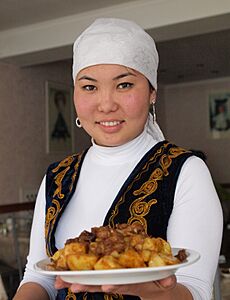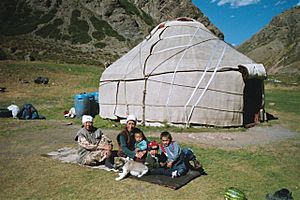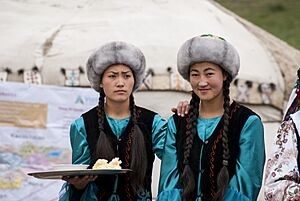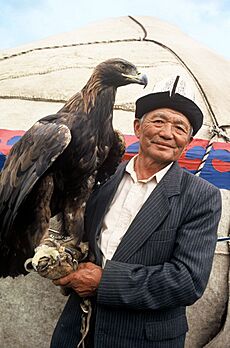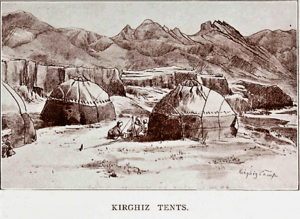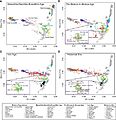Kyrgyz people facts for kids
| кыргыздар qyrğyzdar قىرغىزدار |
|
|---|---|

Kyrgyz falconer in the Barskoon valley
|
|
| Total population | |
| c. 5–6 million | |
| Regions with significant populations | |
| 4.9 million | |
| 450,000 | |
| 202,500 | |
| 137,780 | |
| 65,000 | |
| 38,606 | |
| 2,000 | |
| 4,000 | |
| 1,130 | |
| 1,128 | |
| 1,055 | |
| 6,607 | |
| Languages | |
| Kyrgyz | |
| Religion | |
| Predominantly Islam Minority Tengrist-Islamic syncretism | |
| Related ethnic groups | |
| Teleuts, Telengits, Altai-Kizhi, Tom Tatars, Baraba Tatars, Sart Kalmyks, Fuyu Kyrgyz, Kazakh, Uzbek, Uyghur | |
|
At the 2009 census, ethnic Kyrgyz constituted roughly 71% of population of Kyrgyzstan (5.36 million). |
|
The Kyrgyz people are a group of people from Central Asia. They are part of the larger Turkic family. Most Kyrgyz people live in Kyrgyzstan, Uzbekistan, China, Pakistan, and Afghanistan. You can also find Kyrgyz communities in Russia, Tajikistan, and Kazakhstan. They speak the Kyrgyz language, which is the official language of Kyrgyzstan.
The first people known as "Kyrgyz" appeared in western Mongolia around 201 BC. Modern Kyrgyz people are partly descended from the Yenisei Kyrgyz. These ancestors lived in the Yenisey river valley in Siberia. The Kyrgyz people were part of several large groups before forming their own states. They had their own kingdom, called the Yenisei Kyrgyz Khaganate, in the 9th century. Later, they formed another Kyrgyz kingdom in the 15th century.
Contents
What Does "Kyrgyz" Mean?
There are a few ideas about where the name Kyrgyz comes from. One popular idea is that it means "a collection of forty tribes." This comes from the Turkic word kyrk (meaning "forty"). The ending -iz is an old way to make a word plural.
The name can also mean "imperishable" or "unconquerable." It is linked to the epic hero Manas. According to a famous story, Manas united 40 tribes to fight against their enemies. Another old story from 1370 says the name comes from 40 women born on a wide, open grassland.
In the 18th and 19th centuries, European writers sometimes used the name Kirghiz for both the modern Kyrgyz people and their relatives, the Kazakhs. To tell them apart, the Kyrgyz were called Kara-Kirghiz (meaning "Black Kirghiz," because of their dark tents). The Kazakhs were called Kaisaks or "Kirghiz-Kazaks."
Where Do Kyrgyz People Come From?
The Kyrgyz are a Turkic ethnic group. Studies of language, genes, and old artifacts suggest that the first Turkic people came from farming groups in Northeast China. They moved west into Mongolia around 3000 BC and became people who raised animals. By 1000 BC, they were skilled riders and nomads. Over time, people living on the steppes of Central Asia slowly became more Turkic. This happened as groups from East Asia moved in from Mongolia.
The Yenisei Kyrgyz were very important in forming the modern Kyrgyz people. They moved to the Tienshan area in the 9th and 10th centuries. Their story begins in western Mongolia. Chinese records from 109-91 BC mention them as Gekun or Jiankun. Later Chinese writings from the 8th-10th centuries called them Jiegu (Kirgut). Their special tribal symbol, called a tamga, looks like the symbols of some modern Kyrgyz tribes today.
An 11th-century Chinese book described the Kyrgyz as having red hair, white skin, and green eyes. A Persian writer from the same time told a story that said these features came from a group called Saqaliba.
The Yenisei Kyrgyz lived in the upper Yenisey River valley in central Siberia. They were part of larger groups like the Tiele people, the Göktürks, and the Uyghur Khaganate.
In 840 AD, the Yenisei Kyrgyz led a revolt that ended the Uyghur Khaganate. This made the Yenisei Kyrgyz very powerful. Their main center moved to Jeti-su. This led to the Kyrgyz spreading south into Tian Shan and Xinjiang. There, they met other groups living in what is now Western China, especially the Tibetan Empire.
The leaders of the Yenisei Kirghiz Khaganate said they were related to a Han Chinese general named Li Ling. This was mentioned in letters between the Kyrgyz leader and the Tang dynasty emperor. The Tang royal family also said they were related to Li Ling's grandfather. The Kyrgyz leader helped the Tang dynasty defeat the Uyghur Khaganate.
The Kyrgyz quickly took control of the Tian Shan mountains and kept it for about 200 years. But in the 12th century, their power became smaller, limited to the Altai and Sayan Mountains. This was because the Mongol Empire was growing. When the Mongol Empire rose in the 13th century, the Kyrgyz moved south. In 1207, Jochi, the oldest son of Genghis Khan, took over Kyrgyzstan without a fight. The Kyrgyz remained under Mongol rule until the late 14th century.
Different Turkic peoples ruled them until 1685. Then, they came under the control of the Oirats (also called Dzungars). This lasted until 1757. Many Kyrgyz tribes who had run away from the Dzungars returned to modern Kyrgyzstan at this time.
By the 16th century, people called Kirgiz lived in South Siberia, Xinjiang, Tian Shan, Pamir-Alay, Middle Asia, the Urals, and Kazakhstan. In the Tian Shan and Xinjiang areas, the name Kyrgyz became a common name for both the Yenisei Kirgiz and the local Turkic tribes. These groups together make up the Kyrgyz people today. While it's hard to say the Yenisei and Tien Shan Kyrgyz are exactly the same, their connections can be seen in old sites, history, language, and culture. Many researchers believe that the ancestors of Kyrgyz tribes came from ancient groups like the Sakas/Scythians, Wusun/Issedones, Dingling, Mongols, and Huns.
Genetic Background
The genetic makeup of the Kyrgyz people shows that they come from a mix of different tribes. This matches their history. Studies show that modern Kyrgyz people have a mix of genes from both East and West Eurasia. This means their ancestors came from both parts of the world.
For example, many Kyrgyz men have a specific genetic marker called Haplogroup R1a1. This marker is common in parts of Europe and Asia. Other Kyrgyz groups, especially in the Southwest, have different genetic markers.
Most Kyrgyz people in Kyrgyzstan have more East Eurasian ancestry. This means their ancestors came from areas like East Asia. However, Kyrgyz people living in Tajikistan and western Kyrgyzstan have a more even mix of East and West Eurasian ancestry. A recent study in 2022 found that Kyrgyz people from China have more West Eurasian ancestry than those in Kyrgyzstan. They are genetically closer to people from Europe and South Asia.
Beliefs and Religion
Most Kyrgyz people are Muslims, following the Sunni branch of Islam. Islam first came to the region with Arab traders traveling along the Silk Road in the 7th and 8th centuries. By the 8th century, Islam reached the Fergana Valley. However, an old Persian text from the 10th century still described the Kyrgyz as people who "venerate the Fire and burn the dead," showing that old beliefs were still strong.
The Kyrgyz began to convert to Islam more widely in the mid-17th century. Sufi missionaries, who are religious teachers, played a big part in this change. By the 19th century, many Kyrgyz were considered strong Muslims. Some even made the Hajj, a religious trip to Mecca.
Today, some old beliefs and practices still exist alongside Islam. These include Shamanism and totemism. Shamans, often women, are still important in funerals, memorials, and other ceremonies. This mix of old and new beliefs is especially seen in Central Kyrgyzstan. In 2007, the daughter of a former Kyrgyz president said that Islam was becoming more popular, even in the northern areas that were once under communist rule. She noted that many mosques have been built and that Kyrgyz people are "increasingly devoting themselves to Islam."
Kyrgyz People Around the World
In Afghanistan
In 2003, there were about 1,130 Kyrgyz people in Afghanistan. They all lived in the eastern part of the Wakhan District. They still live a nomadic life, moving from place to place, and are led by a khan.
In 1916, a rebellion against Russian rule in Central Asia caused many Kyrgyz to move to China and Afghanistan. Most of these Kyrgyz refugees settled in the Wakhan region of Afghanistan. Until 1978, about 3,000 to 5,000 Kyrgyz lived in northeastern Wakhan.
After the Saur Revolution in 1978, most Kyrgyz people in Afghanistan fled to Pakistan. They asked for visas to move to Alaska in the United States, thinking it would have a similar cold climate to their homeland. But their request was denied. The hot, unhealthy conditions in the refugee camp in Pakistan caused many Kyrgyz to get sick. So, Turkey offered to help. In 1982, Turkey moved the entire group to the Lake Van region. They were given a village called Ulupamir (meaning "Great Pamir" in Kyrgyz). More than 5,000 Kyrgyz people still live there today. Some Kyrgyz returned to Wakhan in October 1979 after the Soviet occupation of Afghanistan. They live around the Little Pamir.
In China
The Kyrgyz are one of the 56 ethnic groups officially recognized in China. There are more than 145,000 Kyrgyz in China. They are called Kē'ěrkèzī zú in Chinese.
In the 19th century, Russian settlers moved onto traditional Kyrgyz lands. This pushed many Kyrgyz people across the border into China, increasing their population there. The Chinese areas offered more benefits to the Muslim Kyrgyz compared to the Russian-controlled areas.
The Kyrgyz people in Xinjiang revolted in 1932. They also took part in battles in Kashgar in 1933 and 1934.
Most Kyrgyz in China live in the Kizilsu Kirghiz Autonomous Prefecture in southwestern Xinjiang. Smaller groups live in other nearby areas like Wushi, Aksu, and Taxkorgan. Some also live in northern Xinjiang. In Akto County, a former Kyrgyz tribe now speaks the Uyghur language.
There is a special group called the "Fuyu Kyrgyz." They are a few hundred Yenisei Kirghiz people whose ancestors were moved from the Yenisei river region to Dzungaria in the 17th century. Then, in the 18th century, they were moved again to Manchuria. They now live in Fuyu County in Heilongjiang Province. Their language is related to the Khakas language.
Some Kyrgyz people in China also follow Tibetan Buddhism.
In Pakistan
The Kyrgyz are the only Turkic people originally from Pakistan. Most Kyrgyz in Pakistan live in the north, mainly in Chitral. Kyrgyz is the only Turkic language spoken in Pakistan. There are only a few thousand Kyrgyz left, and many have blended in with the Pashtun or Kho people. They used to be a major group in the Gilgit-Baltistan region. There are also Afghan refugees of Kyrgyz origin in Pakistan. Some Kyrgyz also came from Kyrgyzstan during the Soviet-Afghan War and settled in Pakistan. Some Kyrgyz citizens also work in Pakistan today.
Images for kids
See also
 In Spanish: Kirguises para niños
In Spanish: Kirguises para niños



